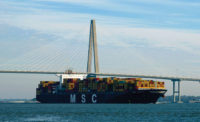As 2016 came to a close, construction industry officials were awaiting hints and signals from President-elect Donald J. Trump and his emerging team of Cabinet nominees. They welcomed his proposed $1-trillion, 10-year infrastructure proposal but still await the details.
Industry groups also praised Trump’s desire to reverse executive orders issued by President Obama and, further, pull back on some of the Obama administration's regulations.
Organized labor and environmental groups—and their Capitol Hill allies—can be expected to fight at least some of those efforts, but Trump’s election and Republicans’ continued control of the House and Senate have strengthened the GOP’s hand in Washington.
Election-year partisanship swirled through Congress in 2016, but lawmakers marshalled enough bipartisan support to approve one significant infrastructure bill. That legislation, which Congress passed near the end of its postelection lame-duck session, was the Water Infrastructure Improvements for the Nation (WIIN) Act.
The WIIN Act’s central component is its Water Resources Development Act title, which authorized $10.3 billion for 30 new Army Corps of Engineers projects that would provide flood protection, harbor dredging, environmental restoration and upgrades to river locks and dams.
In most cases, however, those projects must score appropriations before engineering and design contracts can be awarded. After design is finished, which could take a year or more, construction could follow, but that work also would require appropriations.
The WIIN Act also authorizes non-Corps water programs. They include $1.5 billion for Great Lakes restoration and $415 million for Lake Tahoe.
The legislation also provides $170 million for drinking-water-related needs, including $100 million to upgrade ailing systems in cities such as Flint, Mich.
But as House and Senate negotiators toiled to produce the final version of what became the WIIN Act, they dropped some Senate-backed provisions that water groups were pushing for. Left-out provisions included a $1.8-billion combined-sewer-overflow program authorization and a trust fund to help finance drinking-water and wastewater-treatment projects.
Congress failed to pass a new multiyear authorization for Federal Aviation Administration programs, including the agency’s Airport Improvement Program construction grants. Instead, in July, the House and Senate turned to a familiar Plan B, approving a short-term extension that keeps FAA programs alive through Sept. 30, 2017.
But the FAA stopgap, which President Obama signed on July 15, freezes AIP authorizations until the end of September at their 2016 annual rate of $3.35 billion. The authorizations are subject to annual appropriations. Construction and airport officials had hoped for a long-term FAA authorization, with an increase for the construction grants, in 2016.
Before Congress adjourned, it also was unable to approve full fiscal year 2017 appropriations for nearly all federal agencies, including their construction accounts. Instead, the House and Senate chose another fallback option, passing a stopgap continuing resolution (CR).
The CR, enacted on Dec. 10, keeps most programs’ funding at 2016 levels until April 28. It will be up to the new Congress to pass at least a further extension by that date.
The CR did include $170 million in appropriations for drinking-water repairs and other assistance. Those appropriations match the WIIN Act’s drinking-water-related authorizations and clear another hurdle to releasing long-awaited funds to the localities.
The enacted CR’s flat funding was bad news for state transportation and regional public-transit agencies, as well as engineering and construction groups, because it meant the federal-aid highway and transit funding wouldn’t realize the roughly 2% increases for fiscal 2017 authorized in 2015’s Fixing America’s Surface Transportation (FAST) Act.
Based on American Road & Transportation Association numbers, ENR estimates that, compared with the FAST Act’s levels, the CR’s highway obligation limit is down $905 million and transit funding is down $188 million.
The only full fiscal 2017 appropriations measure to win congressional approval this year was the one covering Dept. of Veterans Affairs programs and military construction. But that legislation trims military construction spending by 5%, to $7.7 billion, from 2016’s level and chops VA’s major-construction program by 58%, to $538 million.
Another noteworthy development was the July announcement that the U.S. Dept. of Transportation had picked 18 winners in the first round of the FAST Act’s five-year, $4.5-billion program for major highway and freight projects. The 18 projects will share $759 million.
DOT selected the 18 projects for what it dubbed the Fostering Advancements in Shipping and Transportation for the Long-Term Achievement of National Efficiencies, or FASTLANE, grants from 212 applications that requested a total of almost $9.8 billion.
Applications closed on Dec. 15 for the second batch of FASTLANE grants. The FAST Act authorizes $850 million for that round of the program. But the actual grant awards are likely to total something less than that amount.
The FASTLANE program is similar to DOT’s nearly eight-year-old Transportation Investment Generating Economic Recover (TIGER) grants. DOT on July 28 announced it had picked 40 projects to receive a total of $484 million in the latest TIGER round, the eighth since the program was launched in 2009. As with FASTLANE, TIGER’s competition was intense: DOT received 585 eligible applications for its 2016 round; the applicants sought a total of more than $9.3 billion.
As the number of applications shows, FASTLANE and TIGER grants are widely popular, but it will be up to the 115th Congress to appropriate funds to keep them going.
Construction industry officials will be scrutinizing Trump’s fiscal 2018 budget request, expected early in 2017, for clearer signals about how he will balance his pro-infrastructure ideas and Republicans’ fiscal hawkishness.




Post a comment to this article
Report Abusive Comment